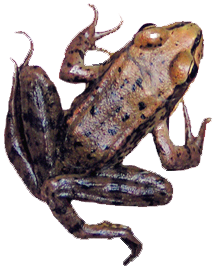We are in the midst of our fifth year ferrying Northern red-legged frogs from steep forest to riparian wetland on the south side of the Portland Basin. We think this frog population lives within the watersheds of Miller, Harborton, and Marine Way Creeks, but we don’t know exactly where they come from, nor from how far up in the forest. Our resident biologist, Sue Beilke, has taken it upon herself to help a population a few miles north of here, centered in the minute town of Burlington, a throwback to a wilder time with an outsized, turreted building that was once a brothel, which is across the highway from the hamlet’s lone business; a strip bar. Despite the sexual overtones that might seem convivial to our amorous hopsters, this rural burg presents the same problem as Harborton; getting across an increasingly intense four lane highway to breed in riverside ponds. Sue is very concerned that that population is close to extirpation, the situation there tougher than ours in that the frogs have to be caught on the shoulder of the busy highway, while at Harborton we have small roads paralleling the highway to work from. Potentially increasing the pressure on that population are proposed mountain bike trails in their habitat, and a housing boom in bedroom communities to the north. That frogs just up the highway are in such peril makes the fate of our Harborton population -- which is literally in our collective hands -- that much more daunting.
A few weeks ago there was an informal meeting with a collection of biologists and ecologists from various governmental agencies; local, state and federal. They looked at the sites where we catch the frogs and we stood in a large circle and had a free-flowing conversation about a lasting solution -- culverts and overpasses -- to this particular frog problem. The tone was optimistic -- federal money was even mentioned -- but such a thing would be prohibitively expensive, millions or tens of millions, and no one really knows if the frogs would use such things, not to mention accommodating the cliffs, and generally awkward landscape at Harborton. I thought of the Fosters, who live toward the top of the anticline, north of Burlington. They dug a lovely half acre pond. “Many” frogs are now using it for breeding, as well as rough-skinned newts! Building ponds on the west side of the highway seems the only feasible long term solution. There is push back against this idea as well, because we’d be abandoning some of the ecological connection between flood plain and upland forest, but a less than perfect solution seems infinitely better than losing these amphibians entirely.
We have some sites that may be suitable for frog ponds, and a commitment from the Oregon Wildlife Foundation to pay for them, but first we need to know if frogs live around the sites; if we dig will they come? As it happens, our need of specific information about these frogs dovetails nicely with a research project recently undertaken by the local county and Portland State University. Three researchers, Leslie Bliss-Ketchum and Amanda Temple of PSU, and Lauren Chan of Pacific University, will be working with to us to better understand our population and hopefully answer these questions: from where in the forest are the frogs migrating, how do they use the structural features of their habitat, and how does this population fit in regionally? The researchers will conduct a telemetry study by fitting the frogs with tiny transmitters, and then use triangulating techniques to track the frogs as they return to their home territories from the wetland. Ms. Chan is studying how population connectivity interacts with, and across, the region's varied landscape characteristics. We'll supply her with dead frogs for DNA testing. (We’ve been collected carcasses for a separate study Sue is heading to determine the ages of the frogs -- by cutting their femurs and counting rings -- like trees.) The genetic testing is aimed at comparing the Harborton frogs with other populations in the region to better understand the relationship between landscape and connectivity between populations. Are populations isolated or connected? How does the nature of the landscape influence their health? How do particular features in a landscape -- restored wetlands, urban parks, man-made ponds -- support populations and facilitate their movement?
After five years it feels like we’re getting beyond buckets and moving in a potentially meaningful direction to help our little friends, but it must be said; no matter what fixes we are able to conjure, unless we humans discover our larger selves, get beyond our juvenile fascination with automobiles, stop chopping the landscape up into ever smaller bits, and learn to live peacefully with all of the Earth’s inhabitants, these beautiful, dignified creatures will continue to hop resolutely, helplessly toward their vanishing point
The Harborton neighborhood and surrounding forest from the south berm of the wetland.

